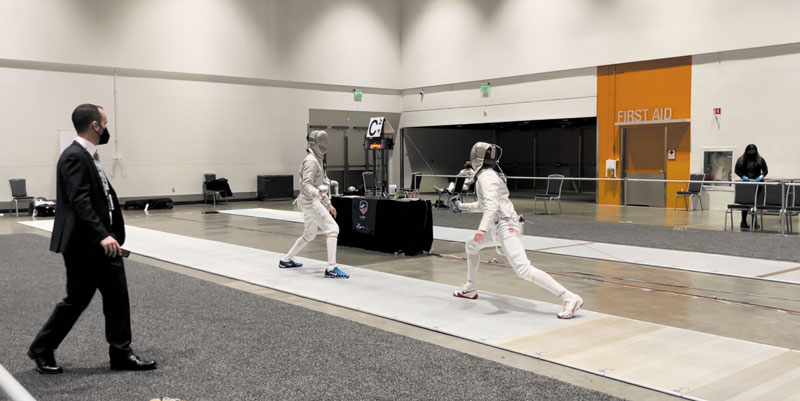
A cut above: Sam Zubatiy competes in fencing at the national level
By Terry L. Wilson
Scripps Ranch High School junior Sam Zubatiy hopes to be an Olympic medalist in the sport of fencing someday. With saber and foil in hand, he is off to a good start.
Zubatiy is slicing through the competition with his latest victory, winning first place at the Battle of the Bay regional competition last February in San Jose, and second place at the Junior Olympics National Team Competition in Salt Lake City.
In 2021, he finished in the top 10 in the nation.
“I began fencing little more than five-years ago,” said the now 16-year-old champion. “I train at the La Jolla Fencing Academy and hope someday to make it to the Olympics.”
Fencing dates back to the 15th century when civilians carried swords. Many things have changed, yet some remain the same: like weapons of choice.
“In fencing you have three different types of weapons: a foil, epee, and saber. I do saber because, in my opinion, the saber is the most aggressive and fast,” Zubatiy said. “The epee is the heaviest sword, the foil is a lighter thrusting weapon, and the sabre is a cutting and thrusting weapon like a cavalry sword.”
In order to register the scores, fencers’ swords and uniforms are electronically sensitive, as are the scoring areas of the body, and are connected by a body cord to the scoring box. When a strike is registered, an audible tone sounds and light illuminates.
With three different weapons come three different uniforms. Although all fencers wear the same base layers, the uniforms are made according to a fencer’s target area.
“An epeeist wears an all white uniform and can only score using the tip of his weapon, so they don’t wear any electrical gear,” Zubatiy said.
“There is a sensor on the tip of the epee, and when the sensor gets pressure it activates a light for a touch score,” he explained. “Because I do sabre fencing, I wear a jacket that indicates different target areas, like arm, hands and the head. I also wear a special electrical rigged wire mesh mask for safety and to record points.”
Strains, sprains, bumps and bruises seem to be the worst case scenario for fencing athletes, and according to Olympic stats, fencing is safer than water polo.
“Fencing is a very safe sport. Before any competition, every weapon and piece of gear is checked,” Zubatiy said. “Actually, the sabers aren’t sharp. In fact, they’re pretty dull. It would have to be a really strong hit to feel something or even get a bruise.”
Most sports have a series of warm-up drills, some unique to that specific sport. The art of fencing requires some fancy back-and-forth footwork called advances.
“We do a lot of footwork drills to perfect our advances and retreats because we attack on a straight line and we retreat on a straight line. There is a lot of footwork in the sport of fencing, but it also requires a lot of mental discipline as well,” Zubatiy said. “We have something called ‘right of way.’ This is where our footwork is important. Basically, the first person to advance, or attack, has the right of way, forcing the opponent backwards. The fencer that makes contact with his blade gets the touch, winning the match.”
After high school graduation, Zubatiy hopes to get a fencing scholarship to an Ivy League college and from there, maybe Olympic Gold.

